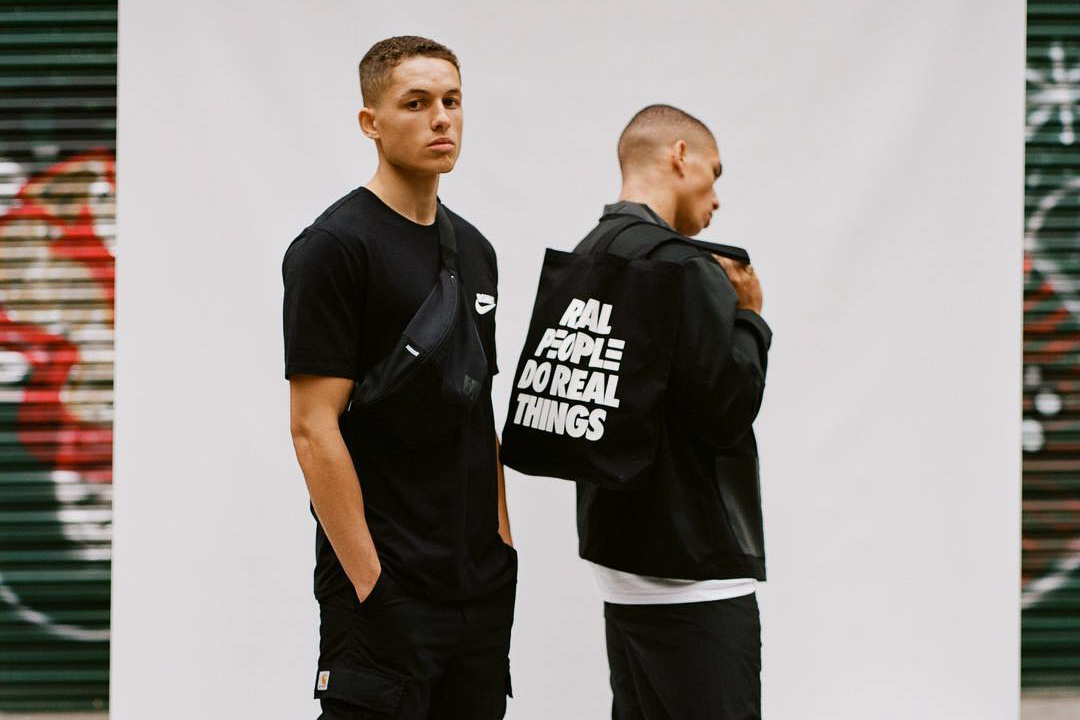What is it that makes streetwear so cool? Originating from America’s surf, skate and hip hop subcultures of the 80s and 90s, perhaps it’s because the whole look represents energy rather than expense. Trainers, loose t-shirts and tracksuits means you can move freely, jump, dance, run or cycle without thinking twice. It’s laid-back, fresh and the uniform of the young. This enthusiasm translates into the community, whether that’s offline (queuing outside brick-and-mortar stores) or online (raving about the latest drop on forums). The vigour of streetwear’s community is contagious.

Historically, streetwear has an anarchistic attitude, which stems from a rebellion against high fashion. Unlike designer brands, streetwear looks effortless and comfortable. The most successful brands know it’s about the everyman, so they appeal to the masses by keeping a close eye on trends and watch how real people are interpreting them, then follow suit. Nowadays, certain brand logos on graphic tees or the latest kicks are top of the shopping list and, for some, they are just as sought-after as a designer handbag. The difference is streetwear fans have never taken themselves too seriously.
The community starts online – many of the top streetwear brands have huge followings and phenomenal engagement stats. Social media goes hand in hand with streetwear; some fans document every outfit every day, which means they need to keep new looks coming at a low (ish) price. Just look at Reddit’s Streetwear Startup subforum where emerging fashion designers post photos and welcome all kinds of feedback from users. It’s a great place to spot new talent and keep an eye on burgeoning trends. Thanks to the internet, fans are welcome to interact with designers, which closes the previously well-established gap between brand and consumer. Now they feel they are having a real impact on building a brand. The Basement is another online group (boasting 75,000 Facebook group members and 276k followers on Instagram) where people from all backgrounds can engage in street culture from home, whether that’s clothes, music or even politics and social issues.

The approachability and accessibility of these virtual forums are far from the stuffy designer shops and glaring members of staff. These online communities also give people the chance to make money by encouraging a resale market. Depop, the peer-to-peer social shopping app, is a cross between eBay and Instagram where teenagers can sell their stuff easily. By inviting small scale entrepreneurism and allowing people to make their own cash from their bedrooms, brands show that they are keen to give back. Through this, streetwear still remains loyal to its roots - the DIY ethos - and their fans love them for it.

It’s not all social media chat either as this dedication is reflected offline too. Streetwear brands prove they are committed to their followers by organising meetups, sponsoring sport events and investing in hangout spots. All this enables the members to meet in real life, bring friends and grow the community even further. In 2014 VANS opened House of VANS under the Waterloo arches, and this year Supreme donated £50,000 to the restoration of London’s Southbank Skate Park because they knew how important this spot was to their teenage fanclub.
However, even though streetwear once represented the gritty underbelly of fashion, these days high-end retailers are producing their own expensive version to reach a new audience. We’re mainly talking teenagers with disposable incomes who are willing to save their pocket money and spend their weekend mornings queuing for the latest releases. This hunger towards a brand is retail gold dust and a number of names in the luxury industry are clocking onto this, from Balenciaga to Gucci. But can they really emulate streetwear’s success and make it seem genuine?

It’s not just about how streetwear fans talk to each other, but often a brand’s tone of voice cuts straight through any pretense or marketing spiel, which makes it human and relatable. The ultimate ‘treat ‘em mean’ fashion players are Palace, for example, who write as if they couldn’t care less whether they make sales: “Your Mum looks like the guy out of Coldplay” is one of their tweets to their 99k followers. This irreverent approach works because it makes people laugh and reads like a real voice you’d hear on the street. The cold, calculated copy of expensive brands does not compare.
When it comes to streetwear, it’s not about cutting-edge design (a couple of letters on a white tee is hardly revolutionary) rather than what the logo signifies: a close community. High-end brands can try to copy the style, but you won’t find the same crowd sticking around for long. The essence of streetwear is about belonging to a tribe where fans match labels with fellow peers. As long as streetwear brands keep treating customers like real people, engaging with them in an authentic way online and offline, they’ll remain infallible.